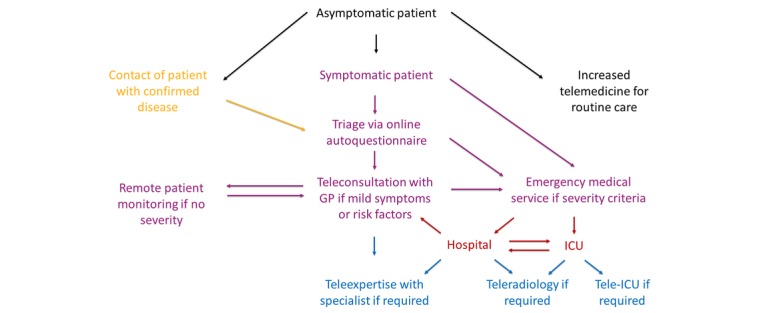Abstract
On March 11, 2020, the World Health Organization declared the coronavirus disease 2019 (CoViD-19) outbreak as a pandemic, with over 720,000 cases reported in more than 203 countries as of 31 March. The response strategy included early diagnosis, patient isolation, symptomatic monitoring of contacts as well as suspected and confirmed cases, and public health quarantine. In this context, telemedicine, particularly video consultations, has been promoted and scaled up to reduce the risk of transmission, especially in the United Kingdom and the United States of America. Based on a literature review, the first conceptual framework for telemedicine implementation during outbreaks was published in 2015. An updated framework for telemedicine in the CoViD-19 pandemic has been defined. This framework could be applied at a large scale to improve the national public health response. Most countries, however, lack a regulatory framework to authorize, integrate, and reimburse telemedicine services, including in emergency and outbreak situations. In this context, Italy does not include telemedicine in the essential levels of care granted to all citizens within the National Health Service, while France authorized, reimbursed, and actively promoted the use of telemedicine. Several challenges remain for the global use and integration of telemedicine into the public health response to CoViD-19 and future outbreaks. All stakeholders are encouraged to address the challenges and collaborate to promote the safe and evidence-based use of telemedicine during the current pandemic and future outbreaks. For countries without integrated telemedicine in their national health care system, the CoViD-19 pandemic is a call to adopt the necessary regulatory frameworks for supporting wide adoption of telemedicine.

Continue reading the original article Global Telemedicine Implementation and Integration Within Health Systems to Fight the CoViD-19 Pandemic: A Call to Action here.
Corresponding Author: ©Robin Ohannessian, Tu Anh Duong, Anna Odone. Originally published in JMIR Public Health and Surveillance, 02.04.2020.
References:
1. Greenhalgh T, Wherton J, Shaw S, Morrison C. Video consultations for covid-19. BMJ 2020 Mar 12;368:m998. [doi: 10.1136/bmj.m998] [Medline: 32165352]
2. Hollander JE, Carr BG. Virtually Perfect? Telemedicine for Covid-19. N Engl J Med 2020 Mar 11. [doi: 10.1056/nejmp2003539]
3. Dorsey ER, Topol EJ. Telemedicine 2020 and the next decade. The Lancet 2020 Mar;395(10227):859. [doi: 10.1016/s0140-6736(20)30424-4]
4. Liu S, Yang L, Zhang C, Xiang Y, Liu Z, Hu S, et al. Online mental health services in China during the COVID-19 outbreak. The Lancet Psychiatry 2020 Apr;7(4):e17-e18. [doi: 10.1016/s2215-0366(20)30077-8]
5. Zhou X, Snoswell CL, Harding LE, Bambling M, Edirippulige S, Bai X, et al. The Role of Telehealth in Reducing the Mental Health Burden from COVID-19. Telemed J E Health 2020 Mar 23. [doi: 10.1089/tmj.2020.0068] [Medline: 32202977]
6. Ohannessian R, Mattos S, Paranhos-Baccalà G, Vanhems P. The role of telemedicine in response to the Zika virus outbreak in Brazil. 2016 Presented at: Zika Summit; April 25, 2016; Paris, France.
7. Ohannessian R. Telemedicine: Potential applications in epidemic situations. European Research in Telemedicine/La Recherche Européenne en Télémédecine 2015 Sep;4(3):95-98. [doi: 10.1016/j.eurtel.2015.08.002]
8. Smith A, Thomas E, Snoswell C, Haydon H, Mehrotra A, Clemensen J, et al. Telehealth for global emergencies: Implications for coronavirus disease 2019 (COVID-19). J Telemed Telecare 2020 Mar 20:1357633X2091656. [doi: 10.1177/1357633×20916567]
9. Paterlini M. On the front lines of coronavirus: the Italian response to covid-19. BMJ 2020 Mar 16;368:m1065. [doi: 10.1136/bmj.m1065] [Medline: 32179517]
10. Remuzzi A, Remuzzi G. COVID-19 and Italy: what next? The Lancet 2020 Mar 13. [doi: 10.1016/s0140-6736(20)30627-9]
11. Innova per l’Italia. La tecnologia e l’innovazione per la lotta al Coronavirus: Le fast call URL: https://innovaperlitalia. agid.gov.it/call2action/index.html [accessed 2020-03-26]
12. Legifrance.gouv.fr. Décret n° 2020-227 du 9 mars 2020 adaptant les conditions du bénéfice des prestations en espèces d’assurance maladie et de prise en charge des actes de télémédecine pour les personnes exposées au covid-19 URL: https:/ /www.legifrance.gouv.fr/affichTexte.do?cidTexte=JORFTEXT000041704122&categorieLien=id [accessed 2020-03-13]
13. Haut Conseil de la santé publique. URL: https://solidarites-sante.gouv.fr/IMG/pdf/new_hcsp-sars-cov-2_patients_fragiles_v3. pdf [accessed 2020-03-14]
14. Lignes directrices pour la prise en charge en ville des patients symptomatiques en phase épidémique de covid-19. 16th March 2020. 2020 Mar 17. URL: https://solidarites-sante.gouv.fr/IMG/pdf/covid-19_doctrine_ville_v16032020finalise.pdf [accessed 2020-03-17]
15. Assurance maladie. 2020 Mar 31. Croissance record du recours à la téléconsultation en mars URL: https://www.ameli.fr/ fileadmin/user_upload/documents/20200331_-CP_Teleconsultations_Covid_19.pdf
16. World Health Organization Regional Office for Europe. Strengthening the Health Systems Response to COVID-19. Technical guidance #1: Maintaining continuity of essential health care services while mobilizing the health workforce for COVID-19 response URL: https://euro.sharefile.com/share/view/sbc0659718fd4c8aa [accessed 2020-03-26]
Abbreviations :
- COVID-19: coronavirus disease 2019
- MERS-CoV: Middle East respiratory syndrome coronavirus
- PHEIC: Public Health Emergency of International Concern
- SARS-CoV: severe acute respiratory syndrome–associated coronavirus